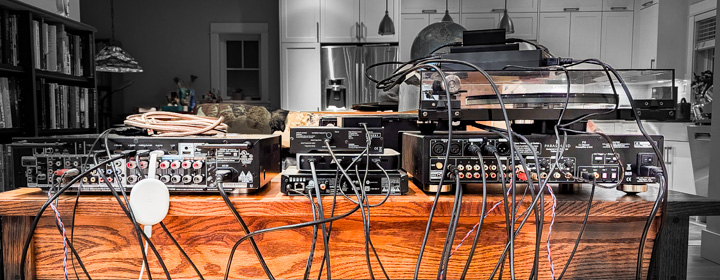
It’s probably part of your life too. What happened was, we moved to a new place and it had a r 2024-11-12 04:0:0 Author: www.tbray.org(查看原文) 阅读量:7 收藏
It’s probably part of your life too. What happened was, we moved to a new place and it had a room set up for a huge TV, so I was left with no choice but to get one. Which got me thinking about TV in general and naturally it spilled over here into the blog. There is good and bad news.
Buying a TV · It’s hard. You visit Wirecutter and Consumer Reports and the model numbers they recommend often don’t quite match the listings at the bigbox Web site. Plus too many choices. Plus it’s deceiving because all the name-brand TVs these days have fabulous pictures.
Having bought a TV doesn’t make me an expert, but for what it’s worth we got a 77" Samsung S90C, which is Samsung’s second-best offering from 2023. Both WC and CR liked it last year and specifically called out that it works well in a bright room; ours is south-facing. And hey, it has quantum dots, so it must be good.
Actually I do have advice. There seems to be a pattern where last year’s TV is often a good buy, if you can find one. And you know where you can often find last year’s good product at a good price? Costco, that’s where, and that’s where we went. Glad we did, because when after a week’s use it frapped out, Costco answered the phone pretty quick and sent over a replacement.
But anyhow, the upside is that you’ll probably like whatever you get. TVs are just really good these days.
Standards! · We were moving the gear around and I snapped a picture of all the video and audio pieces stacked up together. From behind.
The enlarged version of this photo has
embedded
Content Credentials to establish provenance.
Speaking as a guy who’s done standards: This picture is evidence of excellence. All those connections, and the signals they exchange, are 100% interoperable. All the signals are “line-level” (RCA or XLR wires and connectors), or video streams (HDMI), or to speakers (you should care about impedance and capacitance, but 12ga copper is good enough).
Put another way: No two of those boxes come from the same vendor, but when I wired them all up it Just Worked. First time, no compatibility issues. The software profession can only dream of this level of excellence.
Because of this, you can buy all the necessary connectors and cabling super-cheap from your favorite online vendor, but if you’re in Vancouver, go to Lee’s Electronics, where they have everything and intelligent humans will help you find it.
Fixing the picture · Out of the box the default settings yield eye-stabbing brilliance and contrast, entirely unrealistic, suitable (I guess?) for the bigbox shelves.
“So, adjust the picture,” you say. Cue bitter laughter. There are lots of dials to twist; too many really. And how do you know when you’ve got it right? Of course there are YouTubers with advice, but they don’t agree with each other and are short on quantitative data or color science, it’s mostly “This is how I do it and it looks great so you should too.”
What I want is the equivalent of the Datacolor “Spyder” color calibrators. And I wonder why such a thing couldn’t be a mobile app — phonecams are very high-quality these days and have nice low-level APIs. You’d plug your phone into the screen with a USB-C-to-HDMI adapter, it’d put patterns on the screen, and you’d point your phone at them, and it’d tell you how close you are to neutral.
It turns out there are objective standards and methods for measuring color performance; for example, see “Delta-E” in the Tom’s Hardware S90C review. But they don’t help consumers, even reasonably technical ones like me, fine-tune their own sets.
Anyhow, most modern TVs have a “Filmmaker” or “Cinema” setting which is said to be the truest-to-life. So I pick that and then fine-tune it, subjectively. Measurements, who needs ’em?
Privacy · Our TVs spy on us. I have repeatedly read that hardware prices are low because the profit is in mining and selling your watching habits. I’ve not read anything that has actual hard facts about who’s buying and how much they’re paying, but it feels so obvious that it’d be stupid not to believe it.
It’s hopeless to try and keep it from happening. If you’re watching a show on Netflix or a ballgame on MLB.tv, or anything on anything really, they’re gonna sell that fact, they’re up-front about it.
What really frosts my socks, though, is ACR, Automatic Content Recognition, where the TV sends hashed screenshots to home base so it (along with Netflix and MLB and so on) can sell your consumption habits to whoever.
Anyhow, here’s what we do. First, prevent the TV from connecting to the Internet, then play all the streaming services through a little Roku box. (With the exception of one sports streamer that only does Chromecast.) Roku lets you turn off ACR, and Chromecast promises not to. Imperfect but better than nothing.
What to watch? · That’s the problem, of course. It seems likely we’re in the declining tail-end of the Golden Age of TV. The streamers, having ripped the guts out of the cable-TV industry, are turning into Cable, the Next Generation. The price increases are relentless. I haven’t so far seen a general quality decline but I’ve read stories about cost-cutting all over the industry. Even, for example, at Apple, which is currently a quality offering.
And, of course, subscription fatigue. There are lots of shows that everyone agrees are excellent that we’ll never see because I just absolutely will not open my wallet on a monthly basis to yet another outgoing funnel. I keep thinking I should be able to pay to watch individual shows that I want to watch, no matter who’s streaming them. Seems that’s crazy talk.
We only watch episodic TV one evening or so a week, and only a couple episodes at a time, so we’re no danger of running out of input. I imagine being (unlike us) a real video connoisseur must be an (expensive) pain in the ass these days.
But you already knew all that.
Can it work? · Well, yeah. A big honkin’ modern TV being driven by a quality 4K signal can be pretty great. We’re currently watching 3 Body Problem, which has occasional fabulous visuals and also good sound design. I’m pretty sure the data show that 4K, by any reasonable metric, offers enough resolution and color-space coverage for any screen that can fit in a reasonable home. (Sidebar: Why 8K failed.)
The best picture these days is the big-money streamer shows. But not only. On many evenings, I watch YouTube concert videos before I go to bed. The supply is effectively infinite. Some of them are shakycam productions filmed from row 54 (to be fair, some of those capture remarkably good sound). But others are quality 4K productions and I have to say that can be a pretty dazzling sensory experience.
Here are a couple of captures from a well-shot show on PJ Harvey’s current tour, which by the way is musically fabulous. No, I didn’t get it off the TV, I got it from a 4K monitor on my Mac, but I think it gives the feel.
· · ·
Content Credentials here too.
AUDIO visual · In our previous place we had a big living room with the deranged-audiophile stereo in it, and the TV was in a little side-room we called the Video Cave. The new place has a media room with the big TV wall, so I integrated the systems and now the sound accompanying the picture goes through high-end amplification and (for the two front channels) speakers.
It makes more difference than I would have thought. If you want to improve your home-theatre experience, given that TV performance is plateauing, better speakers might be a good option.
Live sports · I like live-sports TV. I acknowledge many readers will find this distasteful, for reasons I can’t really disagree with; not least is maybe encouraging brain-damaging behavior in young men. I can’t help it; decades ago I was a pretty good basketball player at university and a few of those games remain among my most intense memories.
I mean, I like drama. In particular I like unscripted drama, where neither you nor your TV hosts know how the show’s going to end. Which is to say, live sports.
I’ve griped about this before, but once again: The state of the sports-broadcasting art is shamefully behind what the hardware can do.
The quality is all over the map, but football, both fútbol and gridiron, is generally awful. I’ve read that the problem is the expense of the in-stadium broadcast infrastructure, routing all the fat 4K streams to the TV truck and turning them into a coherent broadcast.
In practice, what we’re getting is not even as good as a quality 1080p signal. It’s worth noting that Apple TV’s MLS and MLB broadcasts are noticeably better (the sound is a lot better).
It can only improve, right?
Control how? · When I sit on the comfy video-facing furniture, I need to control Samsung, Parasound, Marantz, Roku, and Chromecast devices. We use a Logitech Harmony; I have another in reserve, both bought off eBay. Logitech has dropped the product but someone is still updating the database; or at least was through 2023, because it knows how to talk to that Samsung TV.
They work well enough that I don’t have to be there for other family members to watch a show. Once they wear out, I have no freaking idea what Plan B is. That’s OK, maybe I’ll die first. And because (as noted above) the audio side has superb interoperability, I can count on upgrading speakers and amplifiers and so on for as long as I last.
Golden age? · Yes, I guess, for TV hardware. As for the shows, who knows? Not my problem; I’m old enough and watch little enough that there’s plenty out there to fill the remainder of my life.
如有侵权请联系:admin#unsafe.sh


